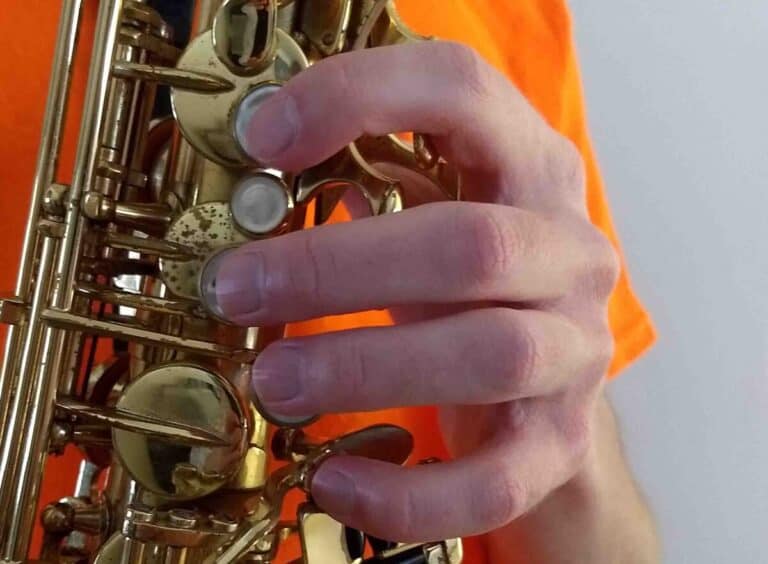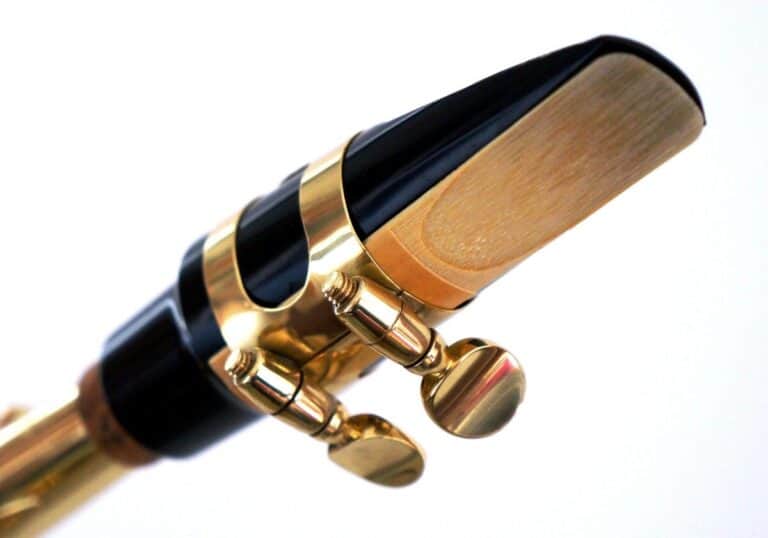Why Does My Saxophone Sound Spitty?
I think every saxophonist at some point deals with the problem of having a spitty sound. I know that it’s personally caused me so much frustration over my years of playing – but I think that at this point I’ve finally beaten it. If you’re here looking to know what causes the spitty sound and how to get rid of it, you’re in the right place.
The most common cause of a spitty sound is moisture caught in the mouthpiece or reed. This can be eliminated by either sucking the moisture out of the mouthpiece or by rubbing the reed on paper to close the pores of the reed. If all else fails, a plastic reed will almost never produce a spitty sound.
| Cause | Diagnosis | Solution | How common is it? |
| Moisture has built up inside the mouthpiece | Try sucking it out with a sharp inhale, and see if it: 1. Goes away, and 2. Does not return | The same method you used to diagnose it. Suck it out. | The most common* |
| Moisture is caught in the pores of the reed | 1. The problem returns shortly after sucking the moisture out of the mouthpiece, and 2. Using a plastic reed resolves the problem | Either: 1. Close the pores on your can reeds before using them, or 2. Use a plastic reed. | Extremely common* |
| Not breathing from diaphragm; not properly supporting one’s sound | Play with a deep breath from your diaphragm and see if the problem goes away | Practice breathing exercises and learn to play with a supported sound | Somewhat common, especially among beginners |
| Moisture is caught in the tone hole of the saxophone neck | Try forcefully blowing into the tone hole of the neck, and see if the problem goes away | The same as the diagnosis. Blow into the tone hole of the neck. | Not very common |
As you can tell from the chart above, a spitty sound is nearly always the result of moisture (that is, spit) being caught somewhere on the instrument, especially in the reed, mouthpiece, and neck areas. The main issue, then, is identifying where the moisture buildup has occurred and knowing how to deal with it. The one exception is the third cause (related to air support), which I’ll address later.
Before I go on, it is worth mentioning that an airy sound is sometimes mistakenly confused as a spitty sound. If you think your sound might be airy rather than spitty, then you’ll want to check out this article instead.
That being said, let’s go through each of the possible causes and their solutions one by one.
Cause #1: Moisture has built up inside the mouthpiece
From my experience, this tends to be the most common cause of a spitty sound. Fortunately, it also tends to be one of the easiest to fix.
A natural result of blowing warm air through your saxophone is the condensation of your breath. Also, you probably tend to blow a lot of saliva through your instrument whether you realize it or not. The combination of these two things frequently results in a large buildup of fluid in the mouthpiece.
When you blow air through a mouthpiece that’s full of spit, the fluid tends to get in the way of your airstream. Hence, the sound comes out as warbly, or spitty.
Diagnosing the problem
The easiest way to determine whether the cause of your spitty sound is due to moisture in the mouthpiece is to try removing the moisture. The easiest way to do this is to sharply inhale through your saxophone to “suck” the fluid out. Alternatively, you could just swab the mouthpiece. If the problem goes away and stays away after removing it, then you’ve solved your problem.
If the spitty sound temporarily goes away but returns shortly after, then this is not the problem. In that case, the problem is most likely cause #2, which I identify as moisture being caught in the pores of the reed. It is often the case that reeds are oversaturated with moisture, but you don’t hear the spit in your sound until just a little moisture ends up in your mouthpiece as well.
Understandably, this can lead to a lot of frustration – sucking the spit out may help in the short term, leading one to falsely believe that’s the solution. However, if the spitty sound returns shortly thereafter, then nothing has really been solved.
If the problem isn’t solved at all, even temporarily, then clearly the cause is something else.
The solution
You can solve a buildup of moisture in the mouthpiece the same way that you diagnose it. However, I’ll go into a bit more detail here, and outline a few different ways that you can remove the moisture.
Solution #1
As mentioned before, the easiest way to remove the moisture is to just suck it out. Put your mouth on your mouthpiece as you normally would while playing. Then, use a fast inhalation (it should make a ‘slurping’ sound) to suck the moisture out. It’s simple and effective.
The one issue with this technique is that it tends to be loud. If you are in the middle of a performance, this may not be ideal. In that case…
Solution #2
You’re still going to suck out the moisture, but there are ways to do it more quietly. Start by putting your mouth on your mouthpiece as you would while playing, but apply much more pressure to the reed than you normally would. Then, inhale quickly to suck up the moisture, but not so quickly that it creates a large slurping sound.
The idea here is to temporarily make the opening of the mouthpiece smaller so that it takes less force to suck the saliva out. It’s not quite as effective as solution #1, but it is quieter and more appropriate for performances.
Solution #3
This solution is only useful if you have a longer amount of time and are able to take your saxophone apart. If you are sounding spitty while practicing, for instance, then you can use this solution (provided that you have correctly identified the cause as being moisture caught in the mouthpiece, of course).
Detach your mouthpiece from your saxophone and remove the reed. Then, simply run a swab through the mouthpiece continuously until it is completely dry. This is the most thorough solution to the problem, but also the one which is least appropriate for performances.
Cause #2: Moisture is caught in the pores of the reed
From my experience, this cause tends to be the most frustrating and difficult to identify. As I mentioned earlier, it is easy to mistake moisture in the pores of the reed for moisture in the mouthpiece. In fact, sucking the moisture out of the mouthpiece may still temporarily solve the problem even if this is the cause.
However, it won’t stay solved. If sucking the moisture out of the mouthpiece temporarily solves the problem, then you may have managed to get just enough moisture out of the reed and mouthpiece to make it sound good again. If the core problem is the reed, however, then you really did only remove a little bit. That moisture will quickly return due to condensation of the breath.
The real issue is that moisture builds up in tiny holes in the reed, called pores. These pores can become filled with fluid. Once the fluid gets inside the pores, it can stay there for a long time – even after the reed has otherwise dried out. It shouldn’t stay there forever, but if you are frequently using a reed which has fluid-filled pores, (and store it in a case with controlled humidity, as you should) then it will essentially never dry out completely.
This is a problem, however, because the fluid inside the pores of the reed can still cause a spitty sound. As such, there needs to be some way to identify this as the problem and to fix it for good.
Diagnosing the problem
This problem is a little bit harder to diagnose because it isn’t as simple as sucking the moisture out. I think that there are two main tells that you may be dealing with a reed that has moisture caught in the pores.
Tell #1: The problem returns shortly after sucking the moisture out
As I mentioned above, sucking moisture out of the mouthpiece won’t really work if the problem is actually the reed. You may find temporary relief since you can typically suck just a bit of the moisture out, but it will be back soon enough.
If this is a frustration you’ve frequently had, you may want to look toward the reed.
Tell #2: Using a plastic reed solves the problem
Though I have by no means forsaken cane reeds, there are many things which I love about plastic reeds. One thing that I love about them is that unlike cane reeds, plastic reeds have no pores. This means that plastic reeds will never become saturated with fluid, and as such will never sound spitty for this reason.
In fact, I find that plastic reeds almost never sound spitty – though it is still possible if the spitty sound is produced for one of the other reasons I mention in this article.
The surest way to determine whether the issue is the reed is to use a high-quality plastic reed. If you don’t already have one, you should probably look into them. They are consistent, effective, and make great backups. You can find a whole article I wrote about plastic reeds here, and you can find my personal recommendation, Legere Signature Series reeds, here.
For our purposes, however, plastic reeds make for both an effective diagnosing tool and an effective backup. They won’t have this issue, so you can use them to identify the problem as the reed. This also makes them a fantastic solution, but I wouldn’t recommend being quick to forsake cane reeds entirely.
You can also try using other cane reeds which you know don’t sound spitty. There are ways to make sure that cane reeds don’t end up sounding spitty, which I’ll save for the solution section below.
Solution
As I alluded to above, there are two main ways to handle a spitty reed. One way is to close the pores of the reed, though this may only work for new reeds and not for reeds which are already spitty. The other way is to use a plastic reed, but this only works as a temporary solution unless you are willing to forsake cane reeds entirely.
Solution #1: Closing the pores of the reed
In order to close the pores of the reed, you’ll need a sheet of ordinary paper. It should not be sandpaper of any kind. Sandpaper is used for serious reed modification, and what we’re doing here isn’t quite in that territory. Printer paper (old pieces of music, perhaps) or notebook paper should be good for our purposes.
To close the pores of the reed:
- Place the paper on a flat surface, such as a table.
- Place the flat side of the reed on the paper. The reed should be dry.
- Quickly rub the reed back and forth on the paper for about a minute.
- Rub a second sheet of paper on the top of the reed toward the tip for about a minute.
Again, this solution may not work on reeds that are already spitty. Once the fluid is inside the pores, closing the pores with the fluid inside probably won’t work. This process is best done on brand-new reeds, as a preventative measure.
Solution #2: Use a plastic reed
As mentioned before, this solution is consistent and effective. The best plastic reeds won’t sound quite as good as the best cane reeds, though – so while this might be effective as a short-term solution, you may want to get in the habit of using solution #1 if you find yourself often struggling with a spitty sound.
Cause #3: Not properly supporting one’s sound
This cause is the oddball of the list. As I’ve said, a spitty sound most commonly comes from moisture somewhere in the saxophone, most often in the mouthpiece or reed. So, it’s pretty weird that shallow breathing would be the cause of a spitty sound.
The explanation here is that it takes a certain amount of force of breath to push the fluid and warm air out of the mouthpiece and into the body of the saxophone. Without using enough air, then, condensation can quickly accumulate inside the mouthpiece.
I must admit that I’ve never personally experienced this issue – I learned to breathe from the diaphragm early on, and even before I did I never noticed a spitty sound which seemed directly related to my breathing. However, I have heard anecdotally that spitty sounds often go away when one uses enough breath support, and so I find it necessary to discuss.
Diagnosis
Quite simply, the way to diagnose this is to use more air and see if the problem goes away. Naturally, this is also ultimately the solution.
In order to use more air, you’ll need to breathe from your diaphragm. Most people breathe from the chest – but the diaphragm is located more in the stomach area. The best way to get a sense for what breathing from the diaphragm feels like is to try lying down. Even if one normally breathes from their chest, they will often still breathe from their diaphragm while lying down (and especially while sleeping).
If you are in an area where you can comfortably do so, I recommend lying down and trying to breathe from your stomach area. Your chest shouldn’t move as you do this. Then, try to do the same while standing up.
Once you’ve gotten the hang of breathing from your diaphragm, I recommend doing a different exercise. Stuff a rag inside your saxophone bell. Then, finger a low B-flat (all keys are down) and try to blow so much air through your instrument as to blow the cloth out of the bell.
You probably won’t be able to do it, because as far as I’m concerned it’s impossible to blow the rag out. However, this is an excellent way to get a sense for how much air support you should have, even though you won’t need to blow so hard in most circumstances.
Solution
The solution to a lack of air support is to practice the exercises above until using lots of air support simply becomes a habit.
Once you learn how to breathe from your diaphragm, try to adjust your habits so that you breathe from your diaphragm by default. You will most likely have to leave yourself reminders, but learning to do this will increase your air support substantially.
You may want to make the “blowing the rag out of the saxophone bell” exercise a habit as well. Through reinforcement of the habit, you can develop an intuitive sense for just how much air you need to be using.
If the cause of your spitty sound truly is a lack of air support, then this should fully take care of the problem.
An alternative way to solve this problem may be to take in more of the mouthpiece. This is sometimes also recommended as a solution, though I have rarely heard of people being successful with it. Nonetheless, it may be worth trying if you are struggling with a spitty sound and the other solutions don’t seem to be cutting it.
Cause #4: Moisture is caught in the tone hole of the saxophone neck
The last solution is also the least common one. Sometimes, moisture can get caught inside the tone hole of the neck (part of the octave key mechanism), creating a small air bubble. This air bubble interferes with sound.
Diagnosis and Solution
As was the case for the other problems, the best way to diagnose this is to try the solution and see if it works.
In this case, the solution is to forcefully blow into the tone hole. Lift up the part of the octave key mechanism which normally covers the tone hole on the neck. Then, in one short burst of air, blow as forcefully as you can into the tone hole. If there was any air bubble in there before, the force of your air should almost certainly pop it.
This is probably the easiest of the above problems to handle. It is also rather uncommon, however, so this would not be my first guess if you are dealing with a spitty sound.
Preventing a spitty sound
We’ve talked about the causes and respective solutions, so now let’s talk about prevention.
If you frequently deal with the problem of having too much moisture buildup in your mouthpiece, you may want to take measures to reduce the amount of saliva in your mouth.
First, make sure that you always brush your teeth before playing if you can – any food left in your mouth can cause extra salivation (not to mention that the food can get into your instrument, which is best avoided). Rinsing with water also helps.
Second, swallow any excess saliva in your mouth before playing. You don’t want your mouth to be completely dry, but it doesn’t help if there’s a lot of extra fluid there. This excess fluid may ultimately end up in your mouthpiece.
The other major cause of a spitty sound that I mentioned had to do with the reed (cause #2), so proper reed care is also important. It may be worthwhile to use the paper trick I described above (in the solution to cause #2) as part of your process for breaking in reeds.
Also, while cane reeds do need to be wet in order to play well, they certainly don’t need to be so wet that they become waterlogged. In fact, it is generally not good for reeds to become waterlogged, as waterlogged reeds have a greater chance of sounding spitty. I typically wet the back end (thicker part) of the reed first, and then wet the thinner part by licking it once or twice. I find that my reeds play effectively this way, and they are less at risk of becoming waterlogged.
Conclusion
If you’re a saxophonist who’s been struggling with a spitty sound, I can at least assure you that I’ve been there. With the exception of cause #3 (lack of air support) which I’ve only heard can be an issue anecdotally, I’ve had my sound go downhill for all of the reasons that I outlined in this article.
I know that it can be frustrating, but I sincerely think that a spitty sound is something that anyone can conquer after a fair amount of troubleshooting and adjustments.
I hope that you’ve found this article helpful in solving your problems – I’ve been through the frustrations of a spitty sound so many times myself that I would like nothing more than for other people to learn from it so as to avoid similar frustrations.
And with that being said, good luck getting rid of your spitty sound!






